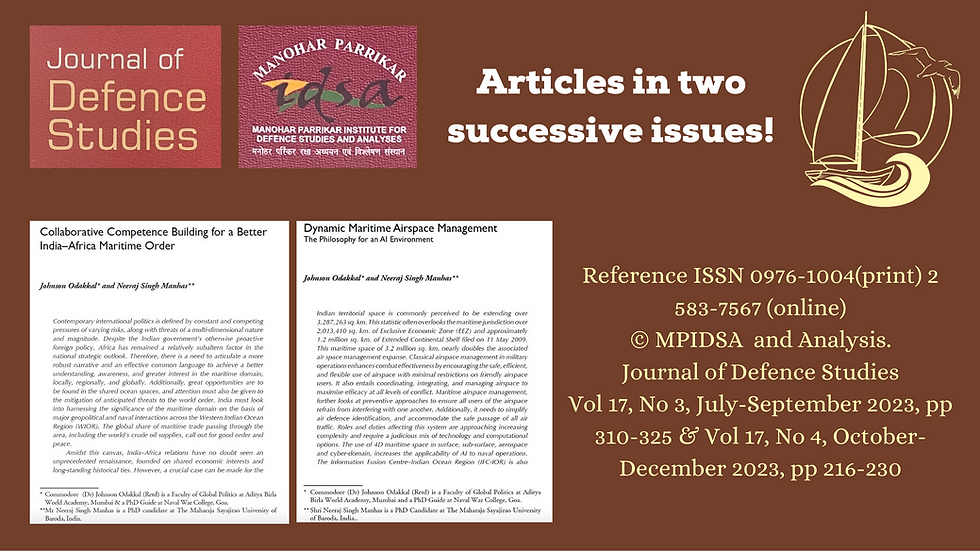Soaring to New Heights: Tribute on World Pilot's Day 2023
- Johnson Odakkal, PhD, CEO

- Apr 26, 2023
- 3 min read
This very day in 1912 Fesa Evrensev (1887-1951), a Turkish pilot took what is considered the first military flight mission. Fesa flew many more missions through 1912-1913 during the Balkan Wars. Later in 1933 he became the first President of Turkish Airlines. (Source ICAO /IFALPA Blog).

As a veteran of the Indian Navy, I often reflect on the amazing opportunity of having worked with some of the finest naval aviators in the world. Watching them soar through the skies in their airborne frigates was like witnessing poetry in motion. This post is not timed to a day or an occasion. It is a reflection on knowing that many of my naval batch mates have superannuated and many among other erstwhile colleagues were brilliant pilots. In terms of this post I do understand that the Indian Navy is a well balanced and multi-dimensional force. Today the reflection and tribute is to my awesome naval aviators!

One of the most remarkable experiences I had as a member of this elite team was working with the Sea Harriers, one of the most impressive fighter jets in the world. When I served for nearly two years aboard the INS Viraat, the pride of the Indian Navy, I would sometimes watch in awe as the Sea Harriers took off and landed with unparalleled precision. I saw sometimes since the longer connection with the “White Tigers”, was in the Main as well as the Mission Briefing Room and the Aircraft Direction Room. A mathematically evolved plan with precision ballet executed on the radar screen was the result of a perfect symphony presenting at times as a carefully choreographed ballet, with each movement executed flawlessly. Crazy fighter aircraft are the Sea Harriers that zoom off the ski jump of the carrier only to land in helicopter slow-mo like a behemoth at the end of the mission. The trap of the Black Panthers (MiG 29K) today aboard INS Vikramaditya is impressive. Yet to me the Short Take Off & Vertical Landing (STOVL) of the Sea Harrier will stay etched in memory.
Long period of mission flying control was an experience provided by the “Harpoons”, the impressive Seaking Mk42B. These aircraft, now ageing, are a versatile flying frigate and the poster arrow of anti-submarine warfare at sea. Watching a Sea King take off from a small frigate deck or the more expansive carrier flight deck was a modern movement of art and awe. 270 minutes of mission flying often in hover and
And then there were the Allouettes, the Chetaks of Indian Navy - the nimble light helicopters that could dart in and out of tight spaces with ease. Known as the “Angels” they remain the work-horses decades after their year of design. It was on one intra-ship transfer on an Allouette I realised how a huge aircraft carrier could appear as a match box sized object on the surface of the sea.
An unusual air machine was the most remarkable Kamov Helicopter and I had the honour to control the KV25 and the KM31 transitioning across a basic anti-submarine version to a potent surveillance mission aircraft. These Russian-made helicopters were unlike anything I had ever seen before. Watching them fly was like watching a dance in the sky, with their contra-rotating rotor blades on a helicopter without a tail rotor rendering a look of disbelief. Aircraft or “egg beater” they were a marvel of Russian avionics.
Working with these incredible machines and the naval aviators who flew them was an experience unlike any other. As an aircraft direction officer, I was responsible for operating the radar display, watching the aircraft as mere blips on the screen. But I was also connected to the naval air warrior through the radio, and that made me feel like I was airborne too.
As I close my eyes and think back to those days, I can feel the wind in my hair, the roar of the engines in my ears, and the thrill of flight coursing through my veins. It was a time of wonder and amazement, of pushing the limits of what was possible, and of feeling like anything was possible.
As we greet and wish Pilot’s I need to emphasise that particularly in Naval Aviation the Naval Air Ops Officer (earlier called Observers) are a close and integral part of Naval Aviation. Mission planning and execution is tactically led by these Air Ops Officers in tandem with their amazing Pilots as collaborators!
To all the naval aviators out there, I want to say thank you. Thank you for allowing me to be a part of your world, for showing me what it means to be a true warrior, and for reminding me of the power of the human spirit. You have touched my life in ways that I cannot fully express, and for that, I will always be grateful.
Do stay in touch for more inspirational stories and always “Maximise Your Message” in collaboration wit #JOI4U at www.johnsonodakkal.com







Those magnificent men in their flying machines. Blue skies, mate.